Physical activity behaviour and barriers to activity in adults at high risk of obstructive sleep apnoea
Sarah Rhodes 1 4 5 , Debra Waters 2 , Ben Brockway 3 , Margot Skinner 1 41 School of Physiotherapy, University of Otago, 325 Great King Street, Dunedin, New Zealand
2 Department of Medicine and School of Physiotherapy, University of Otago, Dunedin, New Zealand
3 Dept of Medicine, University of Otago, Dunedin, New Zealand
4 Centre for Health, Activity, and Rehabilitation Research, School of Physiotherapy, University of Otago, Dunedin, New Zealand
5 Corresponding author. Email: sarah.rhodes@otago.ac.nz
Journal of Primary Health Care 12(3) 257-264 https://doi.org/10.1071/HC19102
Published: 29 September 2020
Journal Compilation © Royal New Zealand College of General Practitioners 2020 This is an open access article licensed under a Creative Commons Attribution-NonCommercial-NoDerivatives 4.0 International License
Abstract
INTRODUCTION: Physical inactivity is a risk factor for disease severity among people with obstructive sleep apnoea.
AIM: To determine physical activity levels in patients at risk of obstructive sleep apnoea and explore their perceptions about barriers to participation in physical activity.
METHODS: This was a cross-sectional observational study. Eligible participants were adults with symptoms of obstructive sleep apnoea hypopnea syndrome and Epworth Sleepiness Scale score ≥11, awaiting prioritisation for a diagnostic overnight sleep study at the local sleep clinic. Sixty participants (mean age ± standard deviation: 51 ± 12 years) each attended an individual appointment. Anthropometric measurements were taken and standardised questionnaires regarding quality of life, physical activity behaviour and perceptions of physical activity were completed.
RESULTS: Over one-third of the cohort did not meet World Health Organization guidelines for weekly physical activity. Hypertension, type 2 diabetes and obesity were also more prevalent in this subgroup. Low motivation and pain were commonly reported barriers to activity in participants not meeting the physical activity guidelines. Overall, 53 (88%) participants stated they would like to be more active.
DISCUSSION: Physical inactivity represents an additional risk factor for adults at high risk of obstructive sleep apnoea. Lack of motivation and pain were the most commonly perceived barriers to participation in activity. Physical activity interventions tailored to the individual, and including a motivational component, need to be included as integral components of management to reduce cardiovascular and metabolic risk factors more effectively in this group.
KEYwords: Non-communicable diseases; sleep health; motivation; telehealth
| WHAT GAP THIS FILLS |
| What is already known: People with obstructive sleep apnoea are likely to be physically inactive. Physical inactivity is an additional risk factor for sleep apnoea severity and cardiovascular health. |
| What this study adds: This study compared the level of physical activity in a group of people at high risk of obstructive sleep apnoea with World Health Organisation physical activity recommendations. It identified barriers to participation in physical activity commonly expressed by participants. |
Introduction
Obstructive sleep apnoea (OSA) is characterised by recurrent partial or complete collapse of the upper airway during sleep, resulting in periods of apnoea and hypopnea with associated oxygen desaturation and sleep disturbance. OSA is estimated to affect 24% of middle-aged males and 9% of middle-aged females and is part of the broader epidemic of non-communicable diseases that globally account for over 16 million deaths prematurely.1 Untreated OSA is independently associated with hypertension, diabetes, increased risk of stroke and sudden cardiac death.2 Globally, obesity has reached epidemic proportions, with its prevalence increasing almost three-fold between 1975 and 2016.3 There is a strong association between obesity and the presence of OSA; 40–60% of obese individuals are estimated to have OSA and, of those diagnosed with the condition, 70% are obese.4
The World Health Organization (WHO) has highlighted insufficient physical activity as the fourth leading risk factor for death globally.5 Low levels of physical activity have been linked to OSA severity in individuals and physical inactivity is a recognised determinant for elevated blood pressure in people with high cardiovascular disease risk.6,7 The American Heart Association and American College of Cardiology, in their 2017 reclassification of Stage 1 hypertension,8 recommended first-line intervention management be based around a lifestyle approach including increased physical activity levels. Meeting physical activity guidelines has established health benefits in the general population, including maintenance of weight and reduced risk of cardiovascular disease, hypertension and diabetes.9 Even a small increase in physical activity is associated with a 14% lower risk of all-cause mortality than being physically inactive.10
The current WHO recommendation for aerobic exercise for adults is a minimum of 150 minutes of moderate-intensity aerobic physical activity a week or at least 75 minutes of vigorous-intensity aerobic physical activity a week, or an equivalent combination of both.5 The New Zealand Ministry of Health physical activity guidelines for adults mirror these recommendations.11 Globally, 25% of adults do not meet physical activity guidelines5 and low physical activity levels contribute to obesity risk.3
The American Thoracic Society OSA guidelines (2018) recommend exercise as a treatment option for patients with OSA who are overweight or obese, and the guidelines advocate lifestyle interventions that incorporate an increase in physical activity.12 Despite evidence to support the benefits of physical activity for people with OSA,4 mean activity levels are lower than recommendations and numerous challenges to activity exist.13,14 One way to increase and maintain the uptake of physical activity in adults at high risk of OSA may be through supported behaviour change. However, to modify behaviour, it is first necessary to understand patient perspectives and consider reasons for initial and ongoing lack of participation and barriers to change in this population.
The aim of our study was to explore physical activity levels and determine barriers and attitudes to activity in a sample of adults at high risk of OSA.
Methods
Participants were recruited from patients referred to the Sleep Clinic at Dunedin Public Hospital. All referred patients were triaged by the Clinic’s consultant physician as part of routine clinical practice. Patients assessed as being at high risk of OSA were invited to participate in the research.
Inclusion criteria were patients aged ≥18 years referred to the Sleep Clinic with symptoms typical of obstructive sleep apnoea hypopnea syndrome (including daytime sleepiness and an Epworth Sleepiness Scale15 score ≥11), who were on the waiting list for an overnight sleep study. Participants were recruited over a four-month period and data for each adult were collected during a single session.
Informed consent was obtained from all participants. Ethical approval was granted by the University of Otago Ethics Committee (Health).
Standardised anthropometric measures were undertaken for height (Charder HM200P portable stadiometer, Charder Electronic Co, Taichung City, Dali District, Taiwan), weight (Seca 813 electronic flat scale, SECA UK, Birmingham, UK), resting blood pressure (OMRON HEM-7221 monitor, OMRON Corporation, Kyoto, Keihanshin, Japan), resting heart rate (EDAN H100, pulse oximeter), oxygen saturation (EDAN H100 pulse oximeter, EDAN USA, San Diego, CA, USA) and neck and waist circumferences (anthropometric tape measure). Participants self-reported their medical history and prescribed medications. Questionnaires were used to explore physical activity habits and barriers to activity. The Global Physical Activity Questionnaire16 is designed to measure the extent and type of physical activity undertaken in a typical week, and allows comparison with current WHO guidelines for activity. It has been used in patient groups with a wide range of non-communicable diseases. The Barriers to Activity Questionnaire is a Likert scale questionnaire, incorporating a series of statements related to attitudes to physical activity. The questionnaire was created and piloted prior to the study.
The study used a cross-sectional observational design. Statistical analysis was performed by using Microsoft Excel version 5.2.13 v15.0 (Microsoft Corporation, Redmond, WA, USA). Descriptive analysis was used for factors relating to physical activity, lifestyle and limitations to activity.
Results
Of the 66 patients who consented to participate in the study, six did not attend their scheduled session. Full data sets were obtained from 60 participants. Their baseline characteristics are shown in Table 1.
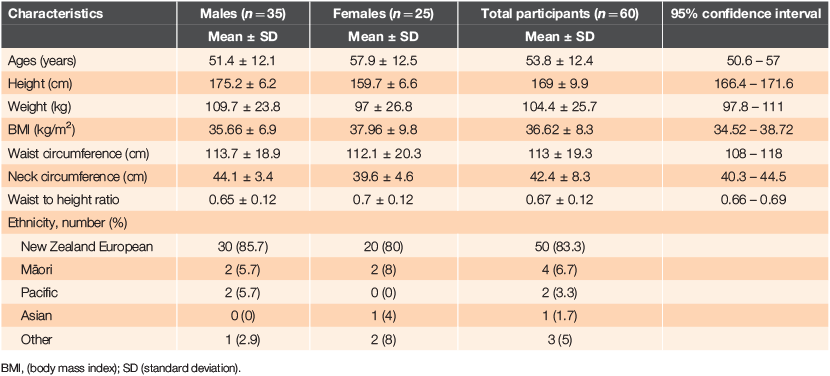
|
Of the 60 participants, 38 (63.3%) met the WHO recommended physical activity guidelines based on the information obtained from self-reports and the Global Physical Activity Questionnaire; 14 participants (23.3%) undertook ≥30 min of total physical activity in a typical week.
Most participants reported more than one co-morbidity. Hypertension, obesity, type 2 diabetes, arthritis and chronic obstructive airways disease were all more common among participants who did not meet WHO physical activity guidelines (Table 2). Fifteen of the 38 (39.5%) participants who met the physical activity guidelines were on anti-hypertensive medications, as were 15 of the 22 (68.2%) who did not (Table 2). Of those prescribed anti-hypertensive medications (n = 30), nine had a systolic blood pressure >140 mmHg recorded during the consultation, as did six who were not on anti-hypertensives. Twenty-seven of our cohort reported some form of arthritis (osteoarthritis, rheumatoid arthritis, gout, psoriatic arthritis, lupus, fibromyalgia). Seventeen self-reported having osteoarthritis of weight-bearing joints, mainly in one or both knees; 15/17 of these participants (88.2%) were obese by Body Mass Index classification.
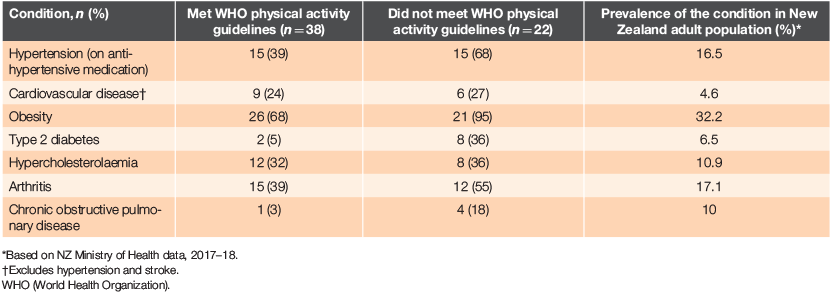
|
Overall, 12 participants (20.0%) were classified as overweight and 46 (76.7%) were classified as obese, of whom 26 were in obesity classes II and III (Figure 1). Of the 22 not meeting the WHO physical activity guidelines, 21 (95.5%) were obese compared to 25 of the 38 (65.8%) participants who met the guidelines (Figure 2).
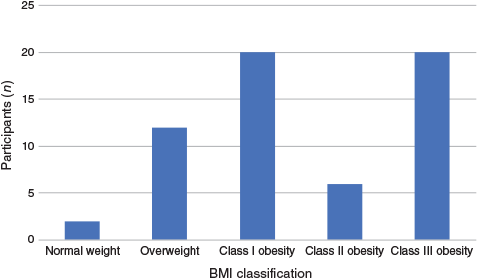
|
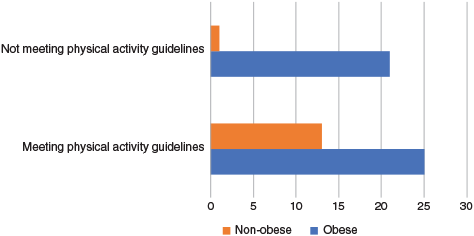
|
Of the 38 participants who met the WHO physical activity guidelines, six indicated they achieved them through occupational activity, seven through recreational means, one solely as a result of active travel and most (24; 63.2%) through a combination of these. The most common activity undertaken was walking, including dog walking (n = 25), followed by housework (n = 8) and gardening (n = 7). Among female participants, 12/25 (48.0%) did not meet the recommended guidelines, compared to 10/35 (28.6%) of the males.
Fifty-three (88.3%) participants used a vehicle as their main form of transport. Of the 22 not meeting the physical activity guidelines, only two (9.1%) engaged in active travel – walking or using a bicycle for at least 10 min continuously to get to and from places in a typical week. This result contrasts with 10 (26.3%) of participants who did meet the physical activity guidelines.
Most participants identified more than one barrier to physical activity, with low motivation being the most commonly cited barrier for patients not meeting the WHO guidelines. Of the participants who did not meet recommended weekly guidelines for physical activity (n = 22), 19/22 (86.4%) agreed or strongly agreed with the statement “I find it hard to motivate myself to undertake physical activity.” Despite this, 20/22 (90.9%) participants stated they would like to be more physically active (Table 3). Whether they met the physical activity guidelines, participants reported that engaging in physical activity ‘made them feel good’, ‘gave them more energy’ and ‘gave them more confidence’. Forty percent (n = 24) of participants expressed worry about ‘doing too much’ when being physically active. Thirteen of the 38 (34.2%) participants who met the physical activity guidelines were concerned about overdoing activity, compared with 11/22 (50.0%) who did not meet the guidelines.
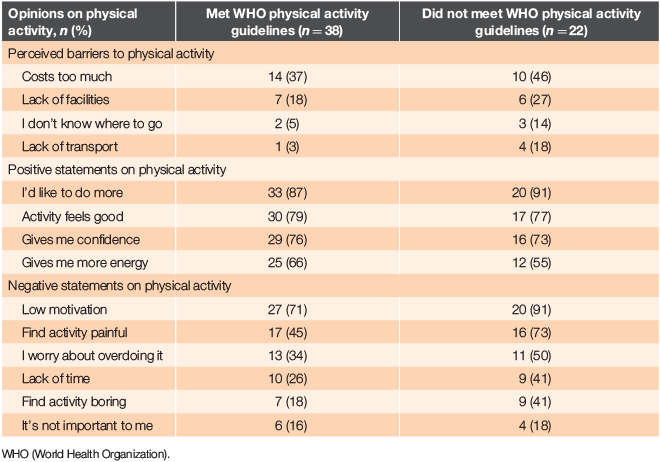
|
Pain was also a common barrier to activity identified by 33 (55.0%) of the study group and was more common in the group not meeting the WHO guidelines (n = 16; 72.4%) than participants meeting the guidelines (n = 17; 44.7%). There was a negative correlation (r = −0.35, P < 0.05) between pain and weekly physical activity levels. Additionally, 24/60 (40.0%) identified cost and 18 (30.0%) perceived ‘lack of time’ as barriers to being physically active.
Discussion
The primary aim of this study was to measure physical activity levels in a sample of adults at high risk of OSA and to explore the barriers they identified and their attitudes to physical activity. Based on self-reports, more than one-third of study participants did not meet the WHO guidelines for weekly physical activity levels. There was an observed trend of low physical activity being more prevalent in females than males, mirroring the wider New Zealand population.17 Recent global data showed that males (55%) were more likely than females (48%) to be physically active for at least 30 min on 5 or more days per week.5
We found that relatively more participants who did not meet the WHO physical activity guidelines were on anti-hypertensive medications (68.2%) than participants who did meet the guidelines (39.5%). This is in line with other research indicating that adults with untreated OSA demonstrate higher rates of hypertension and a ≥5% 10-year risk of fatal cardiovascular disease.18 Regular physical activity is associated with many health benefits including reduced risk for cardiovascular events and modulation of blood pressure.9 Current recommendations for the management of stage 1 hypertension advocate an approach that includes physical activity.8
There is an inverse association between body weight and physical activity levels; adults who are class III obese also demonstrate very low levels of activity, as well as a lower quality of life.19 Our findings are consistent with this literature. The prevalence of obesity across our total study group was high and was reflected in low levels of physical activity; of the group not meeting the physical activity guidelines, 21/22 were classified as obese, including 12 (54.5%) who were class III obese (Figure 2).
Reported active travel was low across both groups, but was three-fold lower in the non-active group. There is evidence that switching from vehicle travel to active travel is associated with a significant reduction in body mass index (BMI) where BMI = weight in kg/height in m2.20 Increasing active travel is one method to support people with high risk of OSA and obesity to meet recommended activity guidelines. Lack of available green space and neighbourhood deprivation are both factors known to affect walking behaviour of people with obesity,21 as are bad weather, poor walking surfaces and lack of places to rest.22 Increasing active travel may address barriers to activity identified by participants in our study, such as lack of transport and cost, if it can be presented as an enjoyable and feasible alternative.
Low motivation was the most commonly reported barrier to activity in our study group. Low motivation is complex, but may be partly attributable to poor self-rated health and low perceived physical capability.23 Patients with co-morbidities often have higher disease burden and lower levels of self-efficacy,24 and self-efficacy is one of the strongest correlates of physical activity behaviour.25 Despite low levels of motivation, most participants wanted to be more physically active and acknowledged the potential benefits of physical activity. To effectively support an individual’s engagement in physical activity, physiotherapists may need to adopt an individualised approach that includes a motivational component, to increase patient self-efficacy and facilitate a sustainable change in physical activity behaviour.
Pain was expressed as a limiting factor across the total cohort. The negative correlation between weekly physical activity levels and pain experienced when being physically active suggests pain did affect the amount of physical activity undertaken. Higher levels of discomfort and anxiety during exercise have been identified as factors that may contribute to lower physical activity adherence rates in adults with OSA who are also obese.26 Furthermore, the link between obesity and arthritis is well established.27 Successful pain management is critical to facilitating increased uptake of physical activity in this group. Low-impact activities, such as hydrotherapy, should be considered.
Fear of adverse effects may influence participation in physical activity, as many of our cohort reported having co-morbidities, including nine who had had a previous myocardial infarction. Fear avoidance behaviours have previously been identified as a barrier to activity in individuals with cardiovascular disease.28 Despite cardiovascular events or other co-morbidities being potential barriers to activity, there is strong evidence that physical activity benefits those with chronic conditions when appropriately managed.29
In common with studies in other patient populations, 40.0% of our study group identified cost as a barrier to activity.30 The implication that physical activity equates to financial expense emphasises the need for better education about what constitutes being physically active. Although access to some exercise facilities may be prohibitively expensive, physical activity does not need to incur a financial cost. Activities such as walking require minimal resources and selecting active travel options may provide cost benefits.
Nearly one-third of our participants perceived ‘lack of time’ as a barrier to being physically active, yet most reported a desire to undertake more physical activity. ‘Lack of time’ due to work and family responsibilities is a recognised barrier to activity30 and research supports the use of interventions that can be incorporated into a daily routine if engagement in physical activity is to be sustained long-term.11
This study provides detail regarding physical activity levels and barriers to activity for people at high risk of OSA that is lacking in most other research; this knowledge is required to successfully support patients’ participation in physical activity. The main study limitation is the self-reporting of data, as it is widely recognised that people tend to overestimate their physical activity levels in self-reported questionnaires. Assessment of daily activity with accelerometry would provide objective data on the activity levels of adults with OSA.
Early recognition and comprehensive management of OSA has the potential to assist in reduction of cardiovascular risk factors and reduce sleep apnoea severity.4 The benefits of physical activity in the management of OSA highlight the importance of physiotherapists’ involvement in providing assessment, education, and individualized exercise prescriptions for their patients. One option to address low motivation as a barrier to activity is the use of a telehealth-based approach, incorporating behavioural change techniques and individualised text messaging.
Conclusion
People at risk of OSA demonstrate a higher rate of lifestyle-related health risk factors than the general population. Physical inactivity is an additional risk factor for people at high risk of OSA. Participants in our study who did not meet the WHO guidelines for weekly physical activity levels also reported higher rates of hypertension, type 2 diabetes and obesity. Our data suggest that low motivation is a common barrier to activity, as reflected in the low levels of physical activity undertaken by the study cohort. It is vital to acknowledge and address such barriers to support greater engagement in physical activity and improve health outcomes.
The complexity of managing both physical and psychological barriers, and supporting individuals to adopt sustained lifestyle changes, is a role that physiotherapists are well qualified to undertake. Strategies that enhance patient motivation need to be considered. One option is the use of telehealth as a motivational tool, alongside personalised exercise prescription, to support the integration of physical activity behaviours into individuals’ lifestyles, thereby reducing health risks.
Competing interests
All authors declare no conflicts of interest.
Funding
This study received no external funding.
Acknowledgement
S. Rhodes wishes to acknowledge the University of Otago in providing her with a PhD scholarship.
References
[1] World Health Organization. Non-communicable diseases and their risk factors. Geneva, Switzerland: The World Health Organization; 2018. [cited 2019 January 23]. Available from: https://www.who.int/ncds/en/[2] Qaseem A, Dallas P, Owens DK, et al. Diagnosis of obstructive sleep apnea in adults: a clinical practice guideline from the American College of Physicians. Ann Intern Med. 2014; 161 210–20.
| Diagnosis of obstructive sleep apnea in adults: a clinical practice guideline from the American College of Physicians.Crossref | GoogleScholarGoogle Scholar | 25089864PubMed |
[3] World Health Organization. 10 facts on obesity. Geneva, Switzerland: The World Health Organization; 2019. [cited 2019 February 14]. Available from: https://www.who.int/features/factfiles/obesity/en/
[4] Araghi MH, Chen YF, Jagielski A, et al. Effectiveness of lifestyle interventions on obstructive sleep apnea (OSA): systematic review and meta-analysis. Sleep. 2013; 36 1553–62.
| Effectiveness of lifestyle interventions on obstructive sleep apnea (OSA): systematic review and meta-analysis.Crossref | GoogleScholarGoogle Scholar | 24082315PubMed |
[5] World Health Organization. Physical activity: key facts. Geneva, Switzerland: The World Health Organization; 2018. [cited 2019 January 17]. Available from: https://www.who.int/news-room/fact-sheets/detail/physical-activity
[6] Young T, Palta M, Dempsey J, et al. The occurrence of sleep-disordered breathing among middle-aged adults. N Engl J Med. 1993; 328 1230–5.
| The occurrence of sleep-disordered breathing among middle-aged adults.Crossref | GoogleScholarGoogle Scholar | 8464434PubMed |
[7] Mendelson M, Tamisier R, Laplaud D, et al. Low physical activity is a determinant for elevated blood pressure in high cardiovascular risk obstructive sleep apnea. Respir Care. 2014; 59 1218–27.
| Low physical activity is a determinant for elevated blood pressure in high cardiovascular risk obstructive sleep apnea.Crossref | GoogleScholarGoogle Scholar | 24282316PubMed |
[8] Whelton PK, Carey RM, Aronow WS, et al. 2017 ACC/AHA/AAPA/ABC/ACPM/AGS/APhA/ASH/ASPC/NMA/PCNA guideline for the prevention, detection, evaluation, and management of high blood pressure in adults: a report of the American College of Cardiology/American Heart Association Task Force on clinical practice guidelines. Hypertension. 2018; 71 e13–115.
| 29133356PubMed |
[9] Mônico-Neto M, Moreira Antunes HK, dos Santos RVT, et al. Physical activity as a moderator for obstructive sleep apnoea and cardiometabolic risk in the EPISONO study. Eur Respir J. 2018; 52 1701972
| Physical activity as a moderator for obstructive sleep apnoea and cardiometabolic risk in the EPISONO study.Crossref | GoogleScholarGoogle Scholar | 30093572PubMed |
[10] Wen CP, Wai JPM, Tsai MK, et al. Minimum amount of physical activity for reduced mortality and extended life expectancy: a prospective cohort study. Lancet. 2011; 378 1244–53.
| Minimum amount of physical activity for reduced mortality and extended life expectancy: a prospective cohort study.Crossref | GoogleScholarGoogle Scholar | 21846575PubMed |
[11] Ministry of Health. Your health: physical activity. Wellington: Ministry of Health; 2016. [cited 2019 February 25]. Available from: https://www.health.govt.nz/our-work/preventative-health-wellness/physical-activity#adults
[12] Hudgel DW, Patel SR, Ahasic AM, et al. The role of weight management in the treatment of adult obstructive sleep apnea. An official American Thoracic Society clinical practice guideline. Am J Respir Crit Care Med. 2018; 198 e70–87.
| The role of weight management in the treatment of adult obstructive sleep apnea. An official American Thoracic Society clinical practice guideline.Crossref | GoogleScholarGoogle Scholar | 30215551PubMed |
[13] Mendelson M, Bailly S, Marillier M, et al. Obstructive sleep apnea syndrome, objectively measured physical activity and exercise training interventions: a systematic review and meta-analysis. Front Neurol. 2018; 9 –73.
| Obstructive sleep apnea syndrome, objectively measured physical activity and exercise training interventions: a systematic review and meta-analysis.Crossref | GoogleScholarGoogle Scholar | 29520251PubMed |
[14] Igelström H, Martin C, Emtner M, et al. Physical activity in sleep apnea and obesity—personal incentives, challenges, and facilitators for success. Behav Sleep Med. 2012; 10 122–37.
| Physical activity in sleep apnea and obesity—personal incentives, challenges, and facilitators for success.Crossref | GoogleScholarGoogle Scholar | 22468930PubMed |
[15] Johns MW. A new method for measuring daytime sleepiness: the Epworth sleepiness scale. Sleep. 1991; 14 540–5.
| A new method for measuring daytime sleepiness: the Epworth sleepiness scale.Crossref | GoogleScholarGoogle Scholar | 1798888PubMed |
[16] Bull FC, Maslin TS, Armstrong T. Global physical activity questionnaire (GPAQ): nine country reliability and validity study. J Phys Act Health. 2009; 6 790–804.
| Global physical activity questionnaire (GPAQ): nine country reliability and validity study.Crossref | GoogleScholarGoogle Scholar | 20101923PubMed |
[17] Ministry of Health. Annual update of key results 2014/2015: New Zealand Health Survey. Wellington: Ministry of Health; 2015.
[18] Mendelson M, Vivodtzev I, Tamisier R, et al. CPAP treatment supported by telemedicine does not improve blood pressure in high cardiovascular risk OSA patients: a randomized, controlled trial. Sleep. 2014; 37 1863–70.
| CPAP treatment supported by telemedicine does not improve blood pressure in high cardiovascular risk OSA patients: a randomized, controlled trial.Crossref | GoogleScholarGoogle Scholar | 25364081PubMed |
[19] Stubbs RJ, Lavin JH. The challenges of implementing behaviour changes that lead to sustained weight management. Nutr Bull. 2013; 38 5–22.
| The challenges of implementing behaviour changes that lead to sustained weight management.Crossref | GoogleScholarGoogle Scholar |
[20] Martin A, Panter J, Suhrcke M, Ogilvie D. Impact of changes in mode of travel to work on changes in body mass index: evidence from the British Household Panel Survey. J Epidemiol Community Health. 2015; 69 753–61.
| Impact of changes in mode of travel to work on changes in body mass index: evidence from the British Household Panel Survey.Crossref | GoogleScholarGoogle Scholar | 25954024PubMed |
[21] Pearson AL, Bentham G, Day P, Kingham S. Associations between neighbourhood environmental characteristics and obesity and related behaviours among adult New Zealanders. BMC Public Health. 2014; 14 553
| Associations between neighbourhood environmental characteristics and obesity and related behaviours among adult New Zealanders.Crossref | GoogleScholarGoogle Scholar | 24894572PubMed |
[22] Lee C, Ory MG, Yoon J, Forjuoh SN. Neighborhood walking among overweight and obese adults: age variations in barriers and motivators. J Community Health. 2013; 38 12–22.
| Neighborhood walking among overweight and obese adults: age variations in barriers and motivators.Crossref | GoogleScholarGoogle Scholar | 22811072PubMed |
[23] Moschny A, Platen P, Klaassen-Mielke R, et al. Barriers to physical activity in older adults in Germany: a cross-sectional study. Int J Behav Nutr Phys Act. 2011; 8 121
| Barriers to physical activity in older adults in Germany: a cross-sectional study.Crossref | GoogleScholarGoogle Scholar | 22047024PubMed |
[24] Peters M, Potter CM, Kelly L, Fitzpatrick R. Self-efficacy and health-related quality of life: a cross-sectional study of primary care patients with multi-morbidity. Health Qual Life Outcomes. 2019; 17 37
| Self-efficacy and health-related quality of life: a cross-sectional study of primary care patients with multi-morbidity.Crossref | GoogleScholarGoogle Scholar | 30764833PubMed |
[25] Bauman AE, Reis RS, Sallis JF, et al. Correlates of physical activity: why are some people physically active and others not? Lancet. 2012; 380 258–71.
| Correlates of physical activity: why are some people physically active and others not?Crossref | GoogleScholarGoogle Scholar | 22818938PubMed |
[26] Smits JAJ, Tart CD, Presnell K, et al. Identifying potential barriers to physical activity adherence: anxiety sensitivity and body mass as predictors of fear during exercise. Cogn Behav Ther. 2010; 39 28–36.
| Identifying potential barriers to physical activity adherence: anxiety sensitivity and body mass as predictors of fear during exercise.Crossref | GoogleScholarGoogle Scholar |
[27] Kulkarni K, Karssiens T, Kumar V, Pandit H. Obesity and osteoarthritis. Maturitas. 2016; 89 22–8.
| Obesity and osteoarthritis.Crossref | GoogleScholarGoogle Scholar | 27180156PubMed |
[28] Bäck M, Öberg B, Krevers B. Important aspects in relation to patients’ attendance at exercise-based cardiac rehabilitation – facilitators, barriers and physiotherapist’s role: a qualitative study. BMC Cardiovasc Disord. 2017; 17 77
| Important aspects in relation to patients’ attendance at exercise-based cardiac rehabilitation – facilitators, barriers and physiotherapist’s role: a qualitative study.Crossref | GoogleScholarGoogle Scholar | 28288580PubMed |
[29] Kirwan JP, Sacks J, Nieuwoudt S. The essential role of exercise in the management of type 2 diabetes. Cleve Clin J Med. 2017; 84 S15–S21.
| The essential role of exercise in the management of type 2 diabetes.Crossref | GoogleScholarGoogle Scholar | 28708479PubMed |
[30] Kelly S, Martin S, Kuhn I, et al. Barriers and facilitators to the uptake and maintenance of healthy behaviours by people at mid-life: a rapid systematic review. PLoS One. 2016; 11
| Barriers and facilitators to the uptake and maintenance of healthy behaviours by people at mid-life: a rapid systematic review.Crossref | GoogleScholarGoogle Scholar | 27997604PubMed |


